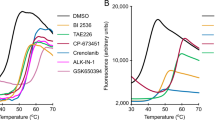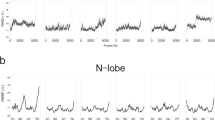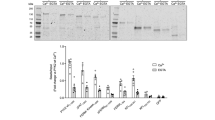Abstract
The calmodulin-binding domain of myristoylated alanine-rich C kinase substrate (MARCKS), which interacts with various targets including calmodulin, actin and membrane lipids, has been suggested to function as a crosstalk point among several signal transduction pathways. We present here the crystal structure at 2 Å resolution of a peptide consisting of the MARCKS calmodulin (CaM)-binding domain in complex with Ca2+-CaM. The domain assumes a flexible conformation, and the hydrophobic pocket of the calmodulin N-lobe, which is a common CaM-binding site observed in previously resolved Ca2+-CaM–target peptide complexes, is not involved in the interaction. The present structure presents a novel target-recognition mode of calmodulin and provides insight into the structural basis of the flexible interaction module of MARCKS.
This is a preview of subscription content, access via your institution
Access options
Subscribe to this journal
Receive 12 print issues and online access
$189.00 per year
only $15.75 per issue
Buy this article
- Purchase on Springer Link
- Instant access to full article PDF
Prices may be subject to local taxes which are calculated during checkout




Similar content being viewed by others
References
Stumpo, D.J., Bock, C.B., Tuttle J.S. & Blackshear, P.J. MARCKS deficiency in mice leads to abnormal brain development and perinatal death. Proc. Natl. Acad. Sci. USA 92, 944–948 (1995).
Aderem, A. The MARCKS brothers: a family of protein kinase C substrates. Cell 71, 713–716 (1992).
Blackshear, P.J. The MARCKS family of cellular protein kinase C substrates. J. Biol. Chem. 268, 1501–1504 (1993).
Matsubara, M., Yamauchi, E., Hayashi, N. & Taniguchi, H. MARCKS, a major protein kinase C substrate, assumes non-helical conformations both in solution and in complex with Ca2+-calmodulin. FEBS Lett. 421, 203–207 (1998).
Wang, J., Arbuzova, A., Hangyas-Mihalyne, G. & McLaughlin, S. The effector domain of myristoylated alanine-rich C kinase substrate binds strongly to phosphatidylinositol 4,5-bisphosphate. J. Biol. Chem. 276, 5012–5019 (2001).
Taniguchi, H. & Manenti, S. Interaction of myristoylated alanine-rich C substrate (MARCKS) with membrane phospholipids. J. Biol. Chem. 268, 9960–9963 (1993).
Jin, C.S., Ahn, J.K., Meadows, G.G. & Joe, C.O. Tob-mediated cross-talk between MARCKS phosphorylation and ErbB-2 activation. Biochem. Biophys. Res. Commun. 283, 273–277 (2001).
Meador, W.E., Means, A.R. & Quiocho, F.A. Target enzyme recognition by calmodulin: 2.4 Å structure of a calmodulin-peptide complex. Science 257, 1251–1255 (1992).
Meador, W.E., Means, A.R. & Quiocho, F.A. Modulation of calmodulin plasticity in molecular recognition on the basis of X-ray structures. Science 262, 1718–1721 (1993).
Osawa, M. et al. A novel target recognition revealed by calmodulin in complex with Ca2+-calmodulin–dependent kinase kinase. Nat. Struct. Biol. 6, 819–824 (1999).
Rhoads, A.R. & Friedberg, F. Sequence motifs for calmodulin recognition. FASEB J. 11, 331–340 (1997).
Yap, K.L. et al. Calmodulin target database. J. Struct. Funct. Genomics 1, 8–14 (2000).
Qin, Z., Wertz, S.L. Jacob, J., Savino, Y. & Cafiso, D.S. Defining protein-protein interactions using site-directed spin-labeling: the binding of protein kinase C substrates to calmodulin. Biochemistry 35, 13272–13276 (1996).
Porumb, T., Crivici, A., Blackshear, P.J. & Ikura, M. Calcium binding and conformational properties of calmodulin complexed with peptides derived from myristoylated alanine-rich C kinase substrate (MARCKS) and MARCKS-related protein (MRP). Eur. Biophys. J. 23, 239–247 (1997).
Matsubara, M., Hayashi, N., Titani, K. & Taniguchi, H. Circular dichroism and 1H NMR studies on the structures of peptides derived from the calmodulin-binding domains of inducible and endothelial nitric-oxide synthase in solution and in complex with calmodulin. J. Biol. Chem. 272, 23050–23056 (1997).
Ulrich, A. et al. Mapping the interface between calmodulin and MARCKS-related protein by fluorescence spectroscopy. Proc. Natl. Acad. Sci. USA 97, 5191–5196 (2000).
Ikura, M. Calcium binding and conformational response in EF-hand proteins. Trends Biochem. Sci. 21, 14–17 (1996).
Schumacher, M.A., Rivard, A.F., Bachinger, H.P. & Adelman, J.P. Structure of the gating domain of a Ca2+-activated K+ channel complexed with Ca2+/calmodulin. Nature 410, 1120–1124 (2001).
Drum, C.L. et al. Structural basis for the activation of anthrax adenylyl cyclase exotoxin by calmodulin. Nature 415, 396–402 (2002).
Elshorst, B. et al. NMR solution structure of a complex of calmodulin with a binding peptide of the Ca2+ pump. Biochemistry 38, 12320–12332 (1999).
Graff, J.M., Young, T.N., Johnson, D. & Blackshear, P.J. Phosphorylation-regulated calmodulin binding to a prominent cellular substrate for protein kinase C. J. Biol. Chem. 264, 21818–21823 (1989).
Palmer, R.H. et al. PRK1 phosphorylates MARCKS at the PKC sites: serine 152, serine 156 and serine 163. FEBS Lett. 378, 281–285 (1996).
Nagumo, H. et al. Rho-associated kinase phosphorylates MARCKS in human neuronal cells. Biochem. Biophys. Res. Commun. 280, 605–609 (2001).
McIlroy, B.K., Walters, J.D., Blackshear, P.J. & Johnson, J.D. Phosphorylation-dependent binding of a synthetic MARCKS peptide to calmodulin. J. Biol. Chem. 266, 4959–4964 (1991).
Blackshear, P.J., Verghese, G.M., Johnson, J.D., Haupt, D.M. & Stumpo, D.J. Characteristics of the F52 protein, a MARCKS homologue. J. Biol. Chem. 267, 13540–13546 (1992).
Matsuoka, Y., Hughes, C.A. & Bennett, V. Adducin regulation. Definition of the calmodulin-binding domain and sites of phosphorylation by protein kinases A and C. J. Biol. Chem. 271, 25157–25166 (1996).
Wang, K.L., Khan, M.T. & Roufogalis, B.D. Identification and characterization of a calmodulin-binding domain in Ral-A, a Ras-related GTP-binding protein purified from human erythrocyte membrane. J. Biol. Chem. 272, 16002–16009 (1997).
Faux, M.C. & Scott, J.D. Regulation of the AKAP79-protein kinase C interaction by Ca2+-Calmodulin. J. Biol. Chem. 272, 17038–17044 (1997).
Pronin, A.N., Satpaev, D.K., Slepak, V.Z. & Benovic, J.L. Regulation of G protein-coupled receptor kinases by calmodulin and localization of the calmodulin binding domain. J. Biol. Chem. 272, 18273–18280 (1997).
Bubb, M., Lenox, R.H. & Edison, A.S. Phosphorylation-dependent conformational changes induce a switch in the actin-binding function of MARCKS. J. Biol. Chem. 274, 36472–36478 (1999).
Wright, P.E. & Dyson H.J. Intrinsically unstructured proteins: re-assessing the protein structure-function paradigm. J. Mol. Biol. 293, 321–331 (1999).
Otwinowski, Z. & Minor, W. Processing of X-ray diffraction data collected in oscillation mode. Methods Enzymol. 276, 307–326 (1997).
Otwinowski, Z. DENZO. in Proceedings of the CCP4 Study Weekend: Data Collection and Processing. (eds. Sawyer, L., Isaacs, N. & Bailey, S.) 56–62 (SERC Daresbury Laboratory, Warrington, UK; 1993).
Navaza, J. AMoRe: an automated package for molecular replacement. Acta Crystallogr. A 50, 157–163 (1994).
Harmat, V. et al. A new potent calmodulin antagonist with arylalkylamine structure: crystallographic, spectroscopic and functional studies. J. Mol. Biol. 297, 747–755 (2000).
Roussel, A. & Cambillau, C. TURBO-FRODO Manual (AFMB-CNRS, Marseille; 1996).
Collaborative Computational Project, Number 4. The CCP4 suite: programs for protein crystallography. Acta Crysallogr. D 50, 760–763 (1994).
Laskowski, R.A., MacArthur, M.W., Moss, D.S. & Thornton, J.M. PROCHECK: a program to check the stereochemical quality of protein structures. J. Appl. Crystallogr. 26, 283–291 (1993).
Li, Z., Rossi, E.A., Hoheisel, J.D., Kalderon, D. & Rubin, C.S. Generation of a novel A kinase anchor protein and a myristoylated alanine-rich C kinase substrate-like analog from a single gene. J. Biol. Chem. 274, 27191–27200 (1999).
Kraulis, P.J. MOLSCRIPT: a program to produce both detailed and schematic plots of protein structures. J. Appl. Crystallogr. 24, 946–950 (1991).
Merritt, E.A. & Murphy, M.E.P. Raster3D version 2.0: a program for photorealistic molecular graphics. Acta Crystallogr. D 50, 869–873 (1994).
Nicholls, A., Sharp, K.A. & Honig, B. Protein folding and association: insights from the interfacial and thermodynamic properties of hydrocarbons. Proteins 11, 281–296 (1991).
Acknowledgements
We are grateful to M. Yamamoto and T. Kumasaka for X-ray diffraction data collection and data processing at beamline BL45XU-SAX. We thank O. de Montellano for providing the human CaM cDNA. This work was supported by Grants-in-Aid for Scientific Research from the Ministry of Education, Culture, Sports, Science and Technology of Japan and by the Japan Society for the Promotion of Science.
Author information
Authors and Affiliations
Corresponding author
Ethics declarations
Competing interests
The authors declare no competing financial interests.
Rights and permissions
About this article
Cite this article
Yamauchi, E., Nakatsu, T., Matsubara, M. et al. Crystal structure of a MARCKS peptide containing the calmodulin-binding domain in complex with Ca2+-calmodulin. Nat Struct Mol Biol 10, 226–231 (2003). https://doi.org/10.1038/nsb900
Received:
Accepted:
Published:
Issue Date:
DOI: https://doi.org/10.1038/nsb900
This article is cited by
-
Pathophysiological roles of myristoylated alanine-rich C-kinase substrate (MARCKS) in hematological malignancies
Biomarker Research (2021)
-
Molecular basis of AKAP79 regulation by calmodulin
Nature Communications (2017)
-
The role of nuclear factor of activated T cells during phorbol myristate acetate-induced cardiac differentiation of mesenchymal stem cells
Stem Cell Research & Therapy (2016)
-
Conformational heterogeneity of the calmodulin binding interface
Nature Communications (2016)
-
Characterization of calmodulin binding domains in TRPV2 and TRPV5 C-tails
Amino Acids (2011)



